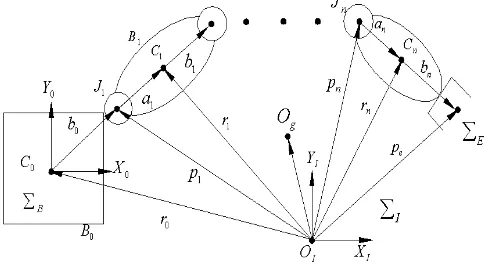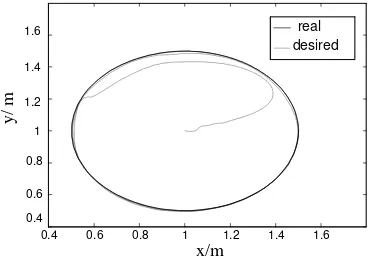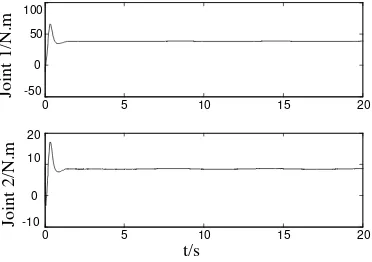DOI: 10.12928/TELKOMNIKA.v12i2.2106 349
Adaptive Control of Space Robot Manipulators with
Task Space Base on Neural Network
Zhou Shuhua1, Ye Xiaoping2*, Ji Xiaoming2, Zhang Wenhui2 1
Fair Friend Institute of Electromechnaics,Hangzhou Vocational and Technical College,
Zhejiang Hangzhou 310000 2
Institute of Technology,Lishui University,Zhejiang Lishui 323000, Telp 0578-2271250, Fax 0578-2271250
*Corresponding author, e-mail: [email protected]
Abstract
As are considered, the body posture is controlled and position cannot control, space manipulator system model is difficult to be set up because of disturbance and model uncertainty. An adaptive control strategy based on neural network is put forward. Neural network on-line modeling technology is used to approximate the system uncertain model, and the strategy avoids solving the inverse Jacobi matrix, neural network approximation error and external bounded disturbance are eliminated by variable structure control controller. Inverse dynamic model of the control strategy does not need to be estimated, also do not need to take the training process, globally asymptotically stable of the closed-loop system is proved based on the lyapunov theory. The simulation results show that the designed controller can achieve high control precision has the important value of engineering application.
Keywords: Neural network Space robotic Adaptive control; Variable structure control
1. Introduction
Space robot has different dynamics and constraints with the ground robot: kinetics of mechanical arm and the base of the coupling, singular, limited fuel supply and limits of attitude control system. These factors lead to space robot show the strong nonlinear dynamics properties, as a result the dynamics and control of space robot than fixed ground robot is complex, not like ground fixed base of robots controlled by general method. For example, the dynamic model of manipulator mass, inertia matrix and load quality cannot be accurately acquired, and external disturbance signals have a certain impact on the controller. To eliminate these non-linear factors, many advanced control strategies such as robust control ref.[1]-[3], adaptive control ref.[4]-[5], fuzzy control ref.[6]-[11] and neural network control ref.[12]-[15] have been used in space robot tracking control. Most of the researches focus on joint-space tracking. However, in many cases, the desired trajectory is described in task-space and the robot is controlled by the torque input in joint-space, this is known as the task-space tracking problem.
Ref.[16]-[17] bring forward adaptive control methods. In the process of designing, the parameters of dynamic equations need be linearized, so complicated pre- calculation is required. Ref.[18] proposes an fuzzy-neural control method which does not requires the exact model of robot. But much parameter is adjusted, that affects the real-time. Ref.[19] has presented a neural network control method, uncertain model can be identified adaptively by neural network, but this control scheme only can guarantee the system uniformly ultimately bounded (UUB).
This paper presents a neural network adaptive control method to copy with tracking problem of space robot manipulators with uncertain kinematics and dynamics with task space. Considering that exact model is difficult to obtain, this control method use the neural network to identify system parameters. Robust controller is designed to eliminate the approximation errors of neural network and external disturbances. The control method neither requires an estimate of inverse dynamic model, nor calculates the inverse Jacobian matrix. Global asymptotic stability of the closed-loop system is proved based on Lyapunov theory. Simulation results show that the controller can achieve higher precision.
2. Dynamic equations of space robot with task space
The Figure 1 shows the model of one-arm space robot. The coordinate system can be defined as follows: B0 : the spacecraft platform, B ii( 1,, )n : the ist link-rod of manipulator,
i
J : the joint which connects Bi1 with Bi, Ci : the mass’ center of Bi, ai, 3 i
b R respectively :
position vector that is from Ji to Ci and from Cito Ji1,
k
i
R
3 : the unit vector of rotativedirection Ji, 3 i
rR : the position vector of the mass’ center Bi, rgR3 : the unknown vector
of the system’s centroid, peR3 : position vector of the manipulator’s end, IiR3 : the inertia
of the link-rod relative to its centroid, OI : the inertial origin, Og : the centroid of the whole
system,
m
i : the mass ofB
i, M1 n
i i
M m
I
E
B respectively : the inherits [image:2.595.178.424.405.537.2]coefficient, manipulator’s end coordinates system, the basic body coordinates system.
Figure 1. Parameters of manipulator
Free-floating space robot dynamic equation can be written as follow ref.[20]:
( ) ( , )
M q qB q q q
(1)Where , , n
q q q R are joint position, velocity and acceleration vectors;M q( )Rn n is symmetric positive definite inertia matrix; 1
( , ) n
R q q q
B
is Coriolis/ centrifugal forces;
n1 R is control torque.As the robot in task is generally given by the Cartesian coordinate system. The paper can select the displacement of the robot’s end-actuator in Cartesian space as the system output
y. Thus the system’s augmentation output can be written as:
( )
Which yRn indicates the positions and attitudes of the manipulator end-actuator in Cartesian coordinates; for planar two link robot, n = 2. When calculating the derivative of it. The paper can get the following equation:
( )
y J q q (3)
In the aboving equation, J q( )[J qb( ) J qr( )] represents the Jacobian matrix,
/
b b
J y q ,Jr y/ qr.
The paper hypothesizes that
J
r is a non-singular matrix, and thenJ
is reversible.Thus by the equation (3) and equation (1), taking the external disturbance
d
into account. The paper finally can obtain the dynamic equation of the space robot in task space:DyCy d
(4)Where , , .
The dynamic equation (4) of space robot in task space has the following properties [21]: Property1:D q( ) is reversible and bounded.
Property2: For anyZRn, there is1 2
T T
D CZ
Z Z .
3. Designed Controller base on Neural Network
For the dynamic model (4) of space robot, the paper can define yr as the reference
trajectory, yd as the ideal trajectory, e t( ) as the position tracking error, r as the filtering error
slip surface, and Rn n as the positive definite matrix, then:
( ) ( ) ( )
r d
y t y t e t (5)
( ) d( ) ( )
e t y t y t (6)
( ) ( ) ( )
r t e t e t (7)
Lemma[22]: Let e t( )h t( )r t( ), which
represents convolution, 1 ( ) ( )h t L H s and H s( ) is a
n n class transfer function with strictly exponentially stable, if
r
L
n2, then n2 neL L, n2
eL ,
e
is continuous. When t ,e0,r0,e0, the error equation of closed-loop system of free-floating space robot can be writted as:r r
DrCrDy Cy d
(8)If the robot modeling is accurate, and
d
0
. The paper can design the following control law equation to guarantee the global asymptotic stability of closed-loop system.r r v
Dy Cy K r
(9)Where Kv represents positive definite matrix. Proof: to take Lyapunov function as:
1 1 1
T T
1
2 T
V r Dr (10)
To calculate its differential, the paper can obtain the following equation:
1
2
T T
Vr Dr r Dr (11)
To combine the closed-loop error equation (8) and the control law equation (9).the paper can get to the following equation:
0
T v
V r K r (12)
However, in practical engineering, the free-floating space robot model D q( ) and
( , )
C q q are difficult to accurately obtain, and the external disturbance
d
exists in system, these nonlinear uncertainties will cause the control performance to degrade.Considering that the neural network has good nonlinear approximation ability. the paper can adopt RBF local generalization network to approximate the uncertain parts D q( ) C q q( , ) in the unknown system. Thus the learning speed can be accelerated greatly and local minimum problems can be avoided. Then the neural network model equation can be written as:
( ) ilT jl( ) d( )
l
D q
q
q ilT
jl( )q
d( )q (13)( , ) ilT jl( ) c( )
l
C q q
z
z ilT
jl( )z
c( )z (14)Where, z
q q, ,il,
il represents weights of the neural network,
jl( )q ,
jl( )zrepresents radial basis function of the input vector. And
d( )q and
c( )z respectively represents its modeling errors, and is assumed to be bounded.Where. The paper respectively define
ˆ and
ˆ
as the estimate value of
and
, and
and
as their estimation errors.ˆ
(15)ˆ
(16)Then the controller equation (9) should be revised as:
ˆ
( T ) (
ˆ
T ) sgn( )r r v s
y y K r k r
(17)Where
k
s
||
E
||
,E
E y
D
r
E y
C
r
d
The adaptive law is designed as:
ˆ { ( )}
i i i q y rr i
(18)ˆi Qi { ( )}i z y rr i
Where
T0
i i ,
0
T
i i
Q
Q
.To put the equation (13) and (14) into the equation (9), and combine into the equation (17) .the paper can get to the following equation:
ˆ ˆ
( T
)
(ˆ
T)
( T )d y c y d yr
(ˆ
T ) sgn( )r v s
y K r k r
(20)
Putting
y
y
r
r
,
y
y
r
r
into the equation(20), and reducing it. the paper can get to:ˆ
( T
)
(ˆ
T)
sgn( )d r c r K rv ks r
(
T )yr (
T
)yr E (21)Putting the equation (8) into the aboving equation to calculate, and the paper can obtain the following equation:
sgn( )
v s
DrCrK rk r (
T )yr (
T
)yr E (22)4. Stability Analysis
The paper can define the following Lyapunov functions to prove the stability of closed-loop system.
Proof:
1 1
1 1
1
1
1
2
2
2
n n
T T T
k k k k k k
k k
V
r Dr
Q
(23)Then 1 1 1 1
1
2
n nT T T T
k k k k k k
k k
V
r Dr
r Dr
Q
(24)In the light of the property (1) and property (2), the aboving equation can be revised as:
1 1
1 1
(
)
n n
T T T
k k k k k k
k k
V
r
Dr
Cr
Q
(25)Putting the equation (22) into the aboving equation (25).the paper can get to the following equation:
1
sgn( )
{
}{
( )}
n
T T T T
v s k k r k
k
V
r K r
k r
r
r E
z x r
1 1
1 1 1
{
}{ ( )}
n n n
T T T
k k r k k k k k k k
k k k
q x r
Q
(26)To put the adaptive law equation (18) and the equation (19) into the aboving equation,
||
||
sk
E
, so the paper can get to the following equation:0
T v
From (27), and taking
k
s
0 |
into account. The paper can get tor
L
n2. From the lemma, the paper can derivee
L
n2
L
2,
n2e
L
, in whiche
is continuous. So whent
,0
e
,r
0
ande
0
.5. Simulation Example
About the free-floating space robot, the table 1 shows two-DOF space robot simulation parameters. m0 500kg,m112kg,m2 10kg,b01.0m,b11.0m,b20.75m,a11.0m,
2 0.75
a m, 2
0 66 .
I kg m , 2
1 1.5 .
I kg m , 2
2 0.5 .
I kg m .
The desired trajectory of the end of space manipulator is:
1d 1 0.5 cos( )
x t x2d 1 0.5 sin(t)
Base initial value: qb 0.1, desired trajectory:0.
The external interferences are: f =[ 0.1sinq1 t,q20.1sin ]t T
The filtered tracking error parameters are: diag(6, 6)
Controller gain: Kv diag(10,10);ks 0.6
[image:6.595.217.403.429.557.2]Neural network initial weights are 0. the width of all basis functions are 10. The center of basis function is randomly selected in the input and output domain. Hidden nodes are 40 bits. The simulation results are shown in the Figure 2 ~ Figure 4. The Figure 2 shows the tracking scenario map of the position of manipulator’s end. The Figure 3 shows desire and real trajectories of base. The Figure 4 shows torque of two joints.
Figure 2. Desire trajectory and real trajectory of end
As can be seen from the Figure 2, the proposed control method can ensure the actual track of the end actuator, and well track the desired trajectory. From the Figure 3, the paper can find that the designed neural network controller may effectively approach unknown model within t = 2 s, and at the same time doesn’t need great control torque.
The further simulations show that the stronger the system’s unknown nonlinearity is, the greater the required control torque is required to achieve better control precision, it is necessary to increase the control torque output. Considering that the space robots usually work under low speed condition in order to maintain their postures, the proposed control method can provide ample time for learning of neural network, and meet fully the requirement of real-time.
0.4 0.6 0.8 1 1.2 1.4 1.6
0.4 0.6 0.8 1 1.2 1.4 1.6
x/m
y/
m
Figure 3. Desire and real trajectories of Base
Figure 4. Control torque of two joints
6. Conclusion
In this paper, an adaptive neural-network controller is proposed to deal with the task space tracking problem of space robot manipulators with uncertain kinematics and dynamics.The tracking controller is model-independent, this control method obtains control laws by the neural network online modeling technology, The neural network approximation errors and external bounded disturbances are eliminated by sliding mode variable structure controller. The control method neither requires an estimate of inverse dynamic model, nor requires a time-consuming training process. Based on the Lyapunov theory, this control method proves global asymptotic stability of the whole closed-loop system. the neural controller can not only achieve higher precision without calculating the inverse Jacobian matrix, so it reduces the calculation quantity, but also meet real-time requirements. So it has great value in engineering applications. Simulation results show that the controller can achieve higher precision.
Acknowledgments
The paper is supported by National science and technology support Plan Project (No.2013BAC16B02), Zhejiang Provincial Natural Science Foundation (No.LZ12F02001) and (No. LY14F030005), Zhejiang Provincial Education Department Science Research Project (No.Y201330000), Zhejiang Provincial Science and Technology Project (No. 2013C3110).
References
[1] Dubowsky S, Papadopoulos EG. The kinematics, Dynam- ics and control of free-flying space robotic systems. IEEE Trans on Robotics and Automation. 1993; 9(5): 531-543.
[2] REN Y, MA Baoli. Adaptive Control of Space Robot System Based on Back stepping Design. Acta
0 5 10 15 20
-50 0 50
Joint 1/N.
m
0 5 10 15 20
-10 0 10 20
t/s
Joint 2/N.
m
100
0 5 10 15 20 -0.15
-0.1 -0.05 0 0.05
0.1
t/s
real desired
Base /r
[image:7.595.204.390.282.413.2]Aeronautica ET Astronautica Sinica. 2007; 28(2): 490-494.
[3] CC Cheah, S Kawamura, S Arimoto, K Lee H. Tuning for Task-Space Feedback Control of Robot With Uncertain Jacobian Matrix. IEEE Trans on Automatic Control. 2001; 46(8): 1313-1318.
[4] Kim YH, Lewis FL. Neural network output feedback control of robot manipulators. IEEE Trans on Robotics and Automation. 1999; 15(2): 301-309.
[5] Zhang W, Fang Y, Ye X. Adaptive Neural Network Robust Control for Space Robot with Uncertainty. TELKOMNIKA. 2013; 11(3): 513-520.
[6] Wang SD, Lin CK. Adaptive control of robot manipulator using fuzzy compensator. Fuzzy Sets Syst. 2000; 110(3): 351-363.
[7] Wang CH, Tsai CH, Lin WS. Robust fuzzy model-following control of robot manipulators. IEEE Trans. Fuzzy Syst. 2000; 8(4): 462-469.
[8] Lin CK. Non-singular terminal sliding model control of robot manipulators using fuzzy wavelet networks. IEEE Trans. Fuzzy Syst. 2009; 160(12): 1765-1786.
[9] Yoo BK, Ham WC. Adaptive control of robot manipulator using fuzzy compensator. IEEE Trans.Fuzzy Syst. 2000; 8(2): 186-199.
[10] Zhang XD, JIA QX, SUN HX, CHU M. The Research of Space Robot Flexible Joint Trajectory Control. Journal of Astronautics. 2008; 29(6): 1865-1869.
[11] Lin CK. H reinforcement learning control of robot manipulators using fuzzy wavelet networks. Fuzzy Sets Syst. 2009; 160(12): 1765 -1786.
[12] Sumit G,Gyanendra KG. .
Application of artificial neural engineering and regression models for forecasting shelf life of instant coffee drink. International Journal of Computer Science Issues. 2011; 8(4): 320-324.
[13] Lewis FL, Kim YH. Intelligent optimal control of robotic manipul- ators using neural networks. Automatica. 2000; 36(9): 1355-1364.
[14] Ma J, Zhang W, Zhu H. Adaptive Control for Robotic Manipulators base on RBF Neural Network. TELKOMNIKA. 2013;11(3): 521-528.
[15] Hong ZB, Cheng L. Self-learning control of space flexible manipulator base on gauss function fuzzy neural network. Engineering mechanics. 2008; 29(6):172-177. (in Chinese)
[16] Chen L. Adaptive and robust composite control of coordinated motion of space robot system with prismatic joint. Proc.of the 4th World Congress on Intelligent Control and Automation, Shanghai, China. 2002; 2: 1255-1259.
[17] Wang J, Liu L-d, Liang B, Wu H-x. Adaptive Control for Space Manipulators in Task Space. space science technology of China. 2000; 12(6): 30-35.
[18] FENG B, MA Guang-cheng, XIE W, WANG C. Design of Intelligent Controller for Space Robot. Journal of Astronautics. 2006; 27(4): 730-734.
[19] XIE J, LIU GL, YAN SZ, XU WF, QIANG WY. Study on Neural Network Adaptive Control Method for Uncertain Space Manipulator. Journal of Astronautics. 2010; 31(1): 123-129.
[20] Wei C, Zhao Y, Tian H. Grasping Control of Space Robot for Capturing Floating Target. Acta Aeronautica ET Astronautica Sinica. 2010; 31(3): 632-637.
[21] FENG B, MA Guang-cheng, XIE W, WANG C. Design of Intelligent Controller for Space Robot in task space. Journal of Astronautics. 2007; 28(4): 149-154.


